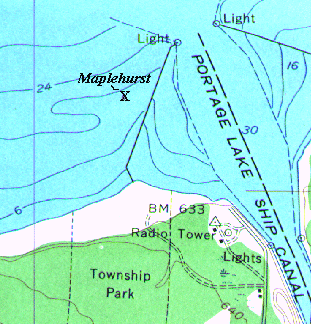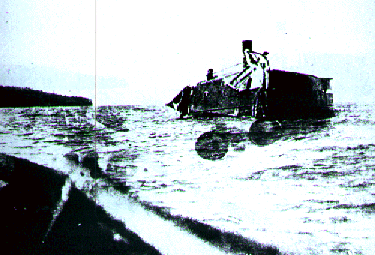
Type: Steel Steamer Length: 235.1 ft. x 36.8 ft. x 15.4 ft., 1297 gt. Depth: 15 - 20 ft. Location: Off West breakwall of North Entry LON/LAT: 47.13' 91" / 88.38' 05"Before dawn on December 1, 1922, the steel steamer Maplehurst was lost off the North Entry in the worst storm of the decade. She was upbound from Lorain, Ohio to Fort William, Ontario with 1800 tons of coal in her hold when the lake began to kick u p. Captain George Menard decided to run for the shelter of Copper Harbor, but could not navigate the narrow entrance in the fierce storm. By midnight, the Maplehurst was off of the North Entry to the Portage Ship Canal and was showing signs of breaking up. Giant waves were sweeping over the length of the ship and demolishing her upper works.
Repeated distress signals by the crew attracted the attention of bosun Charles Tucker of the Portage Lake Lifesaving Station who immediately assembled his crew and put out in the station's small motorboat to rescue the crew of the Maplehurst. After 45 mi nutes in mountainous seas, the lifesavers reached the Maplehurst. In a daring manuever, they positioned their small boat alongside the pitching freighter and called to the crew to jump. Unfortunately, most of the 20 man crew refused to jump, thinking th emselves safer aboard the much larger freighter. After repeated attempts to maneuver alongside the Maplehurst, Tucker had to abandon rescue efforts as his engine was failing and the Maplehurst was looming closer to the breakwall. All told, only 9 of the 20 crew were saved. The Captain and most of his crew perished in the pounding surf.
The Maplehurst had been built by the Chicago Shipbuilding Company for Cleveland Cliffs Iron and was launched at South Chicago in 1892 as the steamer Cadillac. She was powered by a 500 hp triple expansion Scotch Boiler. In 1916, the Cadillac was sold to Canada Steamship Lines and in 1920 she was rechristened as the Maplehurst.
Limited salvage was conducted on the Maplehurst as she was broken in two after fetching up on the bottom just off the breakwall. She was stripped of minor machinery and the next summer she was dynamited as a hazard to navigation.
Today, the remains of the Maplehurst lie just outside the West breakwall at the North Entry. She is completely broken up and partially buried in the sand. The site is fairly shallow and even mild wave action can reduce visibility. The wreckage field li es about 75 yards off of the breakwall and can be reached from it, but the use of a boat is recommended as the lake is often rough. Numerous boat launch sites are available near the North Entry. One of the Maplehurst's liferings is on display at the Boathouse bar in downtown Houghton.


References: Keweenaw Shipwrecks by Fred Stonehouse, Julius F. Wolff Jr.'s Lake Superior Shipwrecks, Divers Guide to Michigan by Steve Harrington, Shipwreck! by David Swayze, Milwaukee Public Library, Runge Collection.